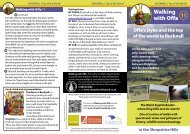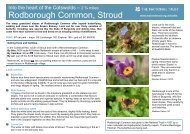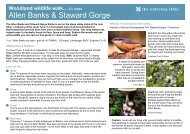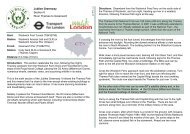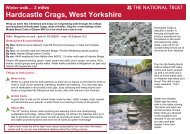Sprivers Wood - Walk4Life
Sprivers Wood - Walk4Life
Sprivers Wood - Walk4Life
- No tags were found...
Create successful ePaper yourself
Turn your PDF publications into a flip-book with our unique Google optimized e-Paper software.
<strong>Wood</strong>land walk… 1 mile<strong>Sprivers</strong> <strong>Wood</strong>, KentTravel back to the 18 th century as you enjoy this gentle walk through <strong>Sprivers</strong> <strong>Wood</strong> inthe heart of the High Weald. Unearth signs of the estate’s World War Two activity andspot a whole host of wildlife, from butterflies to dormice.Start: A267 lay-by - grid ref: TQ 694404 – maps: Explorer 136 & Landranger 188Getting hereBy foot: ¼ mile E of Horsmonden village along a pavementHigh Weald Landscape Trail passes through the estate, a 90 mile path from Horsham to RyeBy bus: Arriva 297 service, Tunbridge Wells to Ashford, passes the lay-by and HorsmondenBy car: 7 miles W of Tunbridge Wells, E of B2162, on A267, Horsmonden to Brenchley roadLocal facilitiesWCs and refreshments in Horsmonden; limited parking in a small lay-by<strong>Sprivers</strong> 18 th century garden is open to the public three times a yearContact us on 01892 893827 or scotneycastle@nationaltrust.org.ukThings to look out for…t <strong>Sprivers</strong> HouseThe <strong>Sprivers</strong> family lived here from 1447 to 1704, when it was purchased by the Courthopefamily, who reconstructed the 15 th century timber-framed house in brick and added a neweast wing. During WW2 the house was used as a military command centre. In the 1960s<strong>Sprivers</strong> and nearby Nap <strong>Wood</strong> came to the National Trust in the will of Robert Courthope.t OaksOak trees from <strong>Sprivers</strong> <strong>Wood</strong> were used to build the Houses of Parliament in 1840 andagain, a hundred years later in 1940, following damage caused by a WW2 air raid.t Coppice<strong>Sprivers</strong> <strong>Wood</strong> contains an area of coppicing, a traditional and sustainable way ofmanaging woodland. Trees are cut down to ground level, lots of new stems re-grow, readyto be harvested again in the future. This cycle can be repeated for hundreds of years andhas the effect of keeping a tree young and healthy. Coppice products are great for makingcharcoal, building railway lines and fences.t WildlifeCoppicing is also important for maintaining a diversity of woodland wildlife, wildflowers,butterflies and dormice all benefit from the increased light levels and shrubbery re-growth.www.nationaltrust.org.uk/walksThe coppice woods andwide woodland tracks area favourite place to findbutterflies, like the commonblue (pictured here) on sunnysummer days. They love tobask in the warm sunshinethat pierces through to theopen spaces and glades.© NTPL / Jonathan PlayerDuring WW2, <strong>Sprivers</strong> <strong>Wood</strong>was used as an ammunitionsdump. You can still seeevidence of the trenches,(pictured here) thought to havebeen built by the British Armyin the run up to the D-Daylandings of 1944.© National Trust / Richard NewmanKeep an eye out for a beechtree (fagus sylvatica) by themoat and pond that has beenreduced to a tall deadwoodstump. As it decays it willattract many insects, batsand birds.© National Trust / Richard Newman"Near the historic village of Horsmonden, famous for its largeironworks and church, <strong>Sprivers</strong> is steeped in history."Richard Newman, National Trust Warden
Directions…1. From the lay-by go through a bridleway gate whichis next to a large field gate. Continue straightdown the tarmac track, passing an old ammunitiondump on your left, before reaching a pond and theold moat which is part of <strong>Sprivers</strong> House.2. Walk between the pond and the moat, keeping thebeech tree on your left.3. Once you have passed the moat, continue down<strong>Sprivers</strong> drive until you reach a metal kissing gate.Go through the kissing gate and then turn right.You will reach a stile. Climb over and walk straightahead through two fields. Cross another stile, andhead for a stile in the top left corner of the wood.Cross this stile into a stand of sweet chestnutcoppice.Terrain and accessibility1 mile (2 km) circular walk along gently undulating, well-trodden paths with several gates and stiles. Somepaths are naturally uneven, others are tarmac. The ¾ mile (1.5 km) shorter route (1-2-5, then return along theroute you came. See red/white dashed line on map) is along tarmac roads and is suitable for pushchairs andwheelchairs. Please keep dogs on lead at all times.© Reproduced by permissionof Ordnance Survey.All rights reserved.OS licence no. AL 1000185914. Take the path in front of you, which will bendaround to your right, following what used to be anavenue of Scots pine trees.5. Eventually you will reach a tarmac road. Turn leftonto this road, and soon after, turn right onto arough dirt track. Follow the track through thewoods to a pair of gates. Go through the first gate,across the dirt track and then through a secondkissing gate.6. Follow the path, with an old ammunition dump onyour right, and when you reach a wide open track,turn left.7. After a short distance along the wide track, turnright along a forest trail until you reach a T-junction. Turn left onto the track which will leadyou back to the entrance gate and where youstarted.As a charity, independent of government, the National Trust relies on the generosity of its supporters to continue caring for our countryside and wildlife,so that everyone can enjoy the beauty of the outdoors for generations to come.Find out more at www.nationaltrust.org.uk



